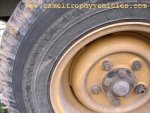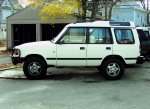No favoring really. 215/85 are fine too, as a skinny versus the wider 245. Skinnies make a lot of sense for many conditions.
Nowhere around here, East Coast, would something that small and that skinny make any kind of sense. I hate it when everyone starts talking about what was run in the Camel Trophy as some sort of universal reference. They dealt with basically stock trucks to keep the competition even and made some modifications (tying racks into the cage) for seriously overloaded conditions. No way would I run anything like what they ran anywhere around here. A 30" tall, 8" wide skinny tire just barely worked for them in many of the events. I bet if you gave them a D1 with 255/85s and 3" of lift, many of the stages wouldve been much easier with less carnage. More tire and more articulation makes for more traction.
A body lift isnt a bad option and it isnt redneck and can be a good solution for some. Ill agree that they have a bad rep for being used on 1/2 ton Chevys and CJ/ YJ's where you see 3-4 inches of space between the body and the frame. They usually do that since their style of wheeling is mud bogging where articulation and load carrying matters not as they just need to clear 44"+ Swampers. Lets say you want to run a small lift with a lighter spring rate since no ones truck is always going to be loaded down 100% of the time. A 1" or 2" spring lift with a 1" body lift might be a good solution. You can clear larger tires for under diff clearance and run a lighter spring rate since HD coils ride like crap when unloaded. Then, that one or two times a month when you actually do go out, you can load it down and not worry so much about rubbing under load as that body lift serves as a buffer in a way.
I would rather have that setup than ride around on the bumpstops all day long. The higher you go, suspension wise, the higher your center of gravity goes, especially when loaded down. Use a body lift to achieve some extra clearance and you can keep your CoG down and keep a little bit of stability. As for your comments about frame ears, Im running a 3 link, 255/85s and 4" of lift and I still bang my frame at times. It happens and if it were that worrisome, I would create some sort of slider for the areas most likely to hit. And yes, I do wheel my D1. Most people here trail ride/ "overland" so a small medium spring rate lift and a small body lift would make for a good solution to clear bigger tires. Bigger tires would allow for more clearance under the diffs and I would, personally, rather have less breakover and depend on my sliders than to bounce my axles off of everything. I like to wheel my D1 so Ive gone mostly suspension but entertain a body lift to gain a little more room to stuff my tires into the wells.



